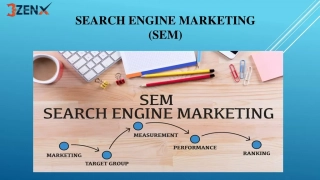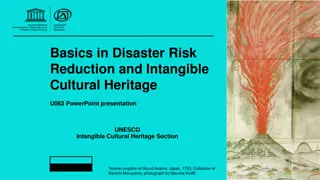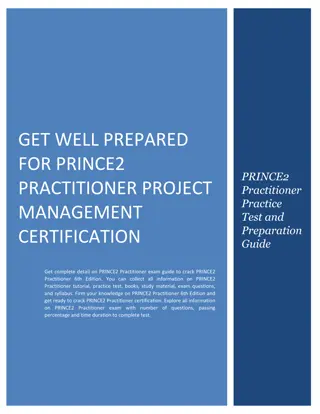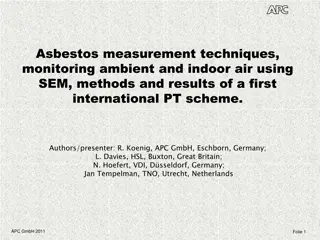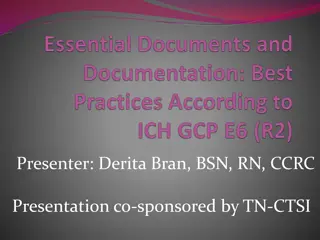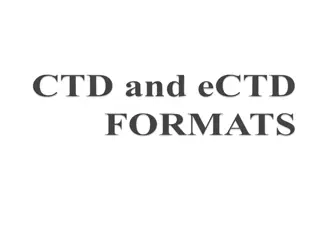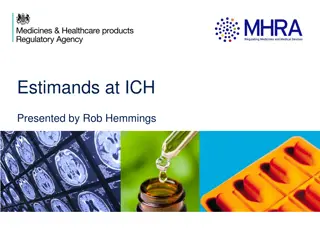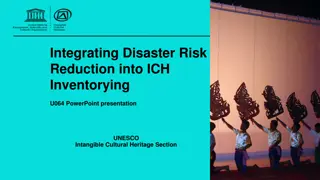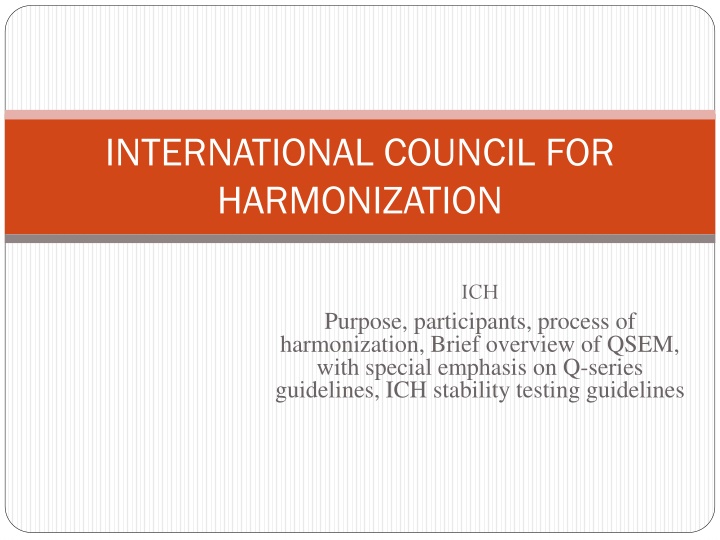
International Council for Harmonization: Guidelines on Stability Testing and Quality Assurance
Explore the purpose, participants, and harmonization process of the International Council for Harmonization (ICH). Learn about Quality System for Effective Management (QSEM), with a focus on Q-series guidelines and ICH stability testing guidelines. Delve into specifics like photostability testing of new drug substances, decision-making based on results, and stability testing for new dosage forms.
Download Presentation

Please find below an Image/Link to download the presentation.
The content on the website is provided AS IS for your information and personal use only. It may not be sold, licensed, or shared on other websites without obtaining consent from the author. If you encounter any issues during the download, it is possible that the publisher has removed the file from their server.
You are allowed to download the files provided on this website for personal or commercial use, subject to the condition that they are used lawfully. All files are the property of their respective owners.
The content on the website is provided AS IS for your information and personal use only. It may not be sold, licensed, or shared on other websites without obtaining consent from the author.
E N D
Presentation Transcript
INTERNATIONAL COUNCIL FOR HARMONIZATION ICH Purpose, participants, process of harmonization, Brief overview of QSEM, with special emphasis on Q-series guidelines, ICH stability testing guidelines
Q1B- Photostability (PS) testing of NDSP To collect the inform. about PS of new molecular entity and associated drug products No information about the PS of drug after administration On Exposure to light no unacceptable changes Carried out on single batch of material Systematic approach: Tests on drug substance Test on exposed drug product outside of the immediate pack Test on drug product in immediate pack Test on drug product in marketing pack
Q1B- Photostability (PS) testing of NDSP Source of light During testing- control of temp. & maintain dark env. Option 1: D65/ID 65 emission standard- artificial day light fluorescent lamp combined with visible , UV, xenon or metal halide lamp. ISO 10977 (1993)- D65- internationally recognized standard for outdoor daylight Option 2: same sample to be exposed to cool white fluorescent lamp in ISO 10977 and near UV lamp. Procedure: expose samples to light of 1.2million lux hrs & emits near UV energy of 200 watt hr/sqmt Compare drug subst. & drug product For confirmation- samples exposed to validated chemical actinometric system/ calibrated radiometers/lux meters to monitor duration of exposure Dark control samples wrapped in aluminium foil kept beside authentic sample
Decision on results For drug substances: Results of confirmatory studies to indicate precautionary measures to be taken during manufacturing so that the degradation of dosage form is avoided during mfg. To ensure that drg remains within limits at the time of its use For dosage forms: Special labeling or packaging depending on degradation of dosage form. Ensure that formulation should comply with the specifications for its quality/safety and therapeutic efficacy during shelf life
Q1C- Stability testing for new dosage forms Issued on October 27th1993 It is annexure to ICH parent stability guideline Tells what is to be submitted in support of stability of new dosage forms by the owner of original application after original submission of NDSP New dosage form? It is the drug product which is different from existing drug product but contains same drug substances as in its existing product approved by Regulatory Authorities Ex: Product of different routes of administration eg. Oral to parenteral New specific functionality/delivery systems eg. Immediate release tablet to modified release tablet Different dosage forms of same administration routes eg. Capsule, tablet, solution to suspension
Q1D Bracketing and matrixing designs for stability testing of NDSP Full study design : samples for every combination of all design factors are tested at all time points Bracketing : design of a stability schedule so that only samples on extremes of certain design factors eg. Strength, container size or fill are tested at all time points as in full design (ex: 15ml-500ml containers extreme) Design assumes that the stability of any intermediate levels is represented by the stability of the extremes tested Design factors are variables: strength, container size/fill to be evaluated in a study design for their effect on product stability Matrixing: is the design of a stability schedule such that a selected subset of the total number of possible samples for all factor combination would be tested at a specified time point At a subsequent time point another subset for all factor combination would be tested Design assumes that the stability of each subset of samples tested represents the stability of all samples at a given time point
Q1E Evaluation of stability data Q1E Evaluation of stability data Tells how to use the stability data generated during stability testing How to use Stability Data to be submitted in registration application for new drug entity Guideline Recommends on establishing retest periods, shelf lives of drug storage at or below RT Covers stability studies using single/multi factor designs and full or reduced designs Purpose of Stability study: To establish retest period or shelf life and label storage instructions Stability information should include data on physical, chemical, biological and microbiological tests and also special to dosage forms like dissolution rate for solid dosage forms
Q1F : Stability Data package for registration applications in climatic zones III and IV It is annexure to parent guideline Q1A (R): Stability testing of NDSP Recommends long term storage condition for stability testing of NDSP for registering application in climatic zones III and IV Following common guidelines are considered to any territory in world Stress testing Selection of batches Container closure system Specification Testing frequency Storage conditions for drug substance or product in a refrigerator Storage conditions for drug subs or product in a freezer Stability commitment Evaluation Statements/labelling
General case as per parent guideline: long term and accelerated storage conditions for climatic zone III and IV Study Storage Condition Minimum time period covered by data at submission 12 months Long term 30 C 2 C/65%RH 5%RH Accelerated 40 C 2 C/75%RH 5%RH 6 months No intermediate storage conditions are recommended in Zone III and IV For aqueous based drug products packaged in semi permeable containers as per parent guidelines Study Storage Condition Minimum time period covered by data at submission 12 months Long term 30 C 2 C/35%RH 5%RH Accelerated 40 C 2 C/25%RH 5%RH 6 months
Q2 ANALYTICAL VALIDATION Done to demonstrate that NS, DP are suitable for intended purpose Should describe each step important to perform each analytical test Sample, reference standard, reagent preparation, use of apparatus, calibration curve, formula for calculations Common analytical procedures: Identification tests, Quantitative tests for impurities, Limit test, Quantitative tests of the active moiety in samples Typical validation characteristics are: Accuracy, Precision, Repeatability, Intermediate precision, specificity, detection limit, quantitation limit, linearity, range
Q3A-Q3D impurities Impurities in New drug substances have 02 aspects Chemistry aspects: classification and identification of impurities, report generation, listing of impurities in specifications, brief discussion of analytical procedures Safety aspects: specific guidelines for those impurities which were not present or in low levels in batches of NDS used in safety and clinical studies
Classification of Impurities Organic impurities Inorganic Residual solvents During storage, Mfg., volatile non-vol. identified/non Results from Mfg. process/ usually known & identified Reagents, ligands, catalysts Inorganic/organic Starting materials Heavy metals/residual metals Of known toxicity By products Degradation products Reagents, ligands, catalysts Inorganic salts Q3C guidelines Filter aids/charcoal/ others
Other impurity guidelines Q3 A (R2) Impurities in New Drug Substances Q3B (R2) Impurities in New Drug Products Q3C (R7) Impurities : Guidelines in Residual solvents Q3 D Guideline for elemental impurities Q3 D (R1) Revision of Q3D Cadmium inhalation Q3D (R2) Revision of Q3D for cutaneous & transdermal products Q3D Training implementation of guideline for elemental impurities
Q4-Q4B PHARMACOPOEIAS Q4 Pharmacopoeias Q4 A Pharmacopoeial Harmonization Q4 B- Evaluation of recommendation of pharmacopoeial texts for use in the ICH regions Q4B- Annex. 1R1 Residue on ignition/sulphated ash Q4B- Annex. 2R1- Test for extractable volume of parenteral preparations Q4 B Annex. 3R1- Test for particulate contamination: Sub visible particles Q4B Annex. 4AR1: microbiological examination of non sterile products: Microbial enumeration tests Q4B Annex. 4BR1: microbiological examination of non sterile products: Tests for specified micro organisms
Q4-Q4B PHARMACOPOEIAS Q4B- Annex. 4CR1 microbiological examination of non sterile products: Acceptance criterion for pharmaceutical preparations & substances for pharmaceutical use Q4B- Annex. 5R1-Disintegration test Q4 B Annex. 6- Uniformity of dosage units Q4B Annex. 7R2:Dissolution test Q4B Annex. 8R1: Sterility Test Q4B Annex. 9R1: Tablet friability Q4B Annex. 10R1: Polyacrylamide Gel electrophoresis Q4B Annex. 11: Capillary electrophoresis Q4B Annex. 12: Analytical sieving Q4B Annex. 13: Bulk density & tapped density of powders Q4B Annex. 14: Bacterial endotoxins test Q4B FAQs Frequently asked questions
Q5 A-Q5E: Quality of Biotechnological Products Q5A (R1): Viral safety evaluation of Biotechnological products derived from cell lines of human of animal origin Q5B Analysis of the expression construct in cells used for production of r-DNA derived protein products Q5C Stability testing of biotechnological / Biological products Q5 D Derivation & characterization of cell substrates used for production of biotechnological / biological products Q5E Comparability of biotechnological / biological products subject to changes in their manufacturing process
Q6 A-Q6B: Specifications Q6A Specifications: Test procedures & acceptance criteria for NDSP, Chemical substances Q6B Specifications: Test procedures and acceptance criteria for biotechnological / biological products Q7: GMP: Outlines the manufacturing of API Q8: Pharmaceutical Development Aim is to design a quality product & its mfg. process Quality should be built in by design Information & knowledge gained from pharmaceutical development studies & mfg. experience provides scientific understanding to support establishment of the design space.
Q9: Quality Risk Management Process for assessment, control, communication, review of risks to quality of drug across life cycle of product Principles: Based on scientific knowledge & links to patient Level of effort, formality and documentation of QRM Coordinate, facilitate and improve sciences based decision making with respect to risk Steps to initiate and plan QRM: Define problem, risk Assemble background information or data on potential hazard, harm, human health impact Identify a leader and resources Specify timeline, deliverables and appropriate level of decision making for risk management process
Q9: Quality Risk Management Risk Assessment Consists of identification of hazards & analysis & evaluation risks Quality Risk Management: Systemic use of information to identify hazards Information includes historic data, theoretical analysis, informed opinions, concerns to stakeholders Risk control Includes decision making to reduce or accept risks Purpose is to reduce risk to an acceptable level
Q10: Pharmaceutical Quality System Management system to direct and control Pharm. company related to quality ICH Q10 based on ISO 9000:2005 Regional GMP requirements, ISO standards & ICH Q7 regional GMP req., ICH Q7 guideline GMP guide for API, ISO quality management system guideliness form foundation of ICH Q10 Continuous improvement across entire product lifecycle
Q11: Development and manufacture of drug substances Addresses the aspects of Development and manufacture including steps designed to reduce the impurities Also provides clarification on ICH on Q8, Q9, Q10. Traditional approach: set points & operating ranges for process parameters. Process reproducibility & testing to meet standard goal Enhanced approach: Risk management & scientific knowledge to identify process parameters, unit operations impacting the critical quality attributes (CQAs)
Q13: Continuous manufacturing (CM) of Drug substances and Drug product CM improves efficiency, expedition, flexibility But lack of regulatory guidelines can make implementation, regulatory approval, lifecycle management challenging, particularly for products for commercialization on International basis ICH guideline facilitate International harmonization Reduces barrier to adoption of CM technology Q14: Analytical Procedure Development Revised ICH Q2 R1 New guidelines for harmonizing the scientific approaches of analytical procedure development Improves regulatory communication b/w Industry & regulators Facilitates efficiency, sound scientific and risk based approval. Include validation principles covering use of spectroscopic or spectrometry data (NMR, Raman, MS)

